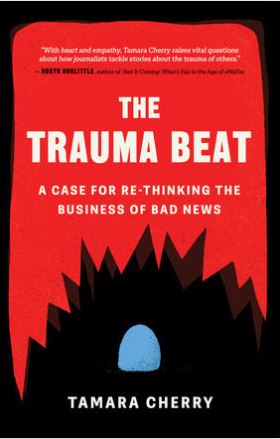As a news anchor (and previously an occasional reporter), I always tried to keep in mind that the subjects of news stories were real people. They were only human, and might be living their worst day as their name – or the name of a loved one – made the news.
There are exceptions, of course. Politicians caught in scandals brought on by greed still deserve fair coverage but we don’t worry about their feelings. Convicted killers are on their own. No one cares what Paul Bernardo thinks about, well, anything at all. Let’s use that heinous monster as an example. While we don’t have to concern ourselves with him, there are the families of his victims to consider. Every time that piece of human garbage makes news, it’s like opening a wound for those families.
How are people traumatized by being in the news?
Trauma. That’s the focus of Tamara Cherry’s book, The Trauma Beat: A Case for Re-thinking the Business of Bad News. Cherry was a crime reporter for 15 years and her book looks at trauma caused to people in the news as well as to journalists. It’s part memoir, part original research, and part interviews with those affected by traumatic events.
Cherry’s ideas are so big they would require a fundamental shift in how newsrooms are run. But she makes so much sense and has amassed so much evidence, that reading her book makes you believe change is possible.
She uses her own experiences with stories she couldn’t shake, and talks to dozens of people about their interactions with the media. Some were preyed upon to an extreme. Others were entirely overlooked although they had compelling, relevant stories to tell. The media isn’t always consistent in the way it decides who gets attention and who doesn’t. How can it be? It’s run by flawed, sometimes biased and sometimes burned out humans.
When You’re in the Spotlight
We’ve seen it a million times but we can’t really imagine what it’s like to wake up to a crowd of camera people and reporters on your lawn. You have to push past them to leave your house. They close in, shout questions, and shove microphones toward your face. It can be terrifying.
The crime beat is tough on journalists, too. They don’t particularly like asking the relative of a murder victim to talk about the deceased but It’s the job. The book asks us to consider whether it always has to be the job. And if so, how we can do it more effectively and more humanely.
Journalists also see and hear things that they are not allowed or choose not to include in their stories. Sometimes police have asked them not to reveal a key piece of evidence. Other times it’s just too gruesome to explain. But they still have that knowledge, that trauma, with them. I explained this in an post last month, as it pertained to the Bernardo case. So many reporters learned details that were kept under a judge’s publication ban. And they had to live with knowing the full horror of what that monster did, despite not being allowed to tell anyone about it.
Families Need to Prepare Themselves
Something the author points out, that I’ve often mentioned, is that families ought to appoint a spokesperson. A trusted friend. A lawyer. Someone who’s not necessarily enthusiastic about doing the job but will be respectful of the family’s wishes. It’s difficult to remember these things in the stress of the moment. Maybe it’s sometime we need to plan for, like what we’d do in case of a fire. Decide how you’d respond, and then forget about it and live your life.
So, what’s missing from news coverage of traumatic events? Humanity. Sensitivity. Follow-up to see whether the person the media has feasted on is okay now that their story is out of the news cycle. An agreement among all news organizations that forcing a devastated family member to answer, “How do you feel?”, is not only heartless, but unnecessary. And there’s a lot more.
Tamara Cherry weaves her work history into The Trauma Beat. Her job affected her deeply and her research showed she’s not alone. And she lets those with first-hand experience talk about their own trauma. Mothers of murdered children. Survivors of fatal traffic accidents. Some names you’ll recognize and many you won’t. Reviewers have said this and I’d like to repeat it: This book should be required reading for journalism students. But it should also be read by anyone who’s currently working as a journalist. It’s about a better way to do the job. And it’s never too late to learn.


I may just have to read this book.
I don’t know how many “pickups” I have done. But there have been scores of them, all done before Facebook offered a thief’s easier perspective at getting a picture of a dead loved one. Every pickup dulled a piece of me. I worked with Tamara. She was a newsroom star and worth the listen.